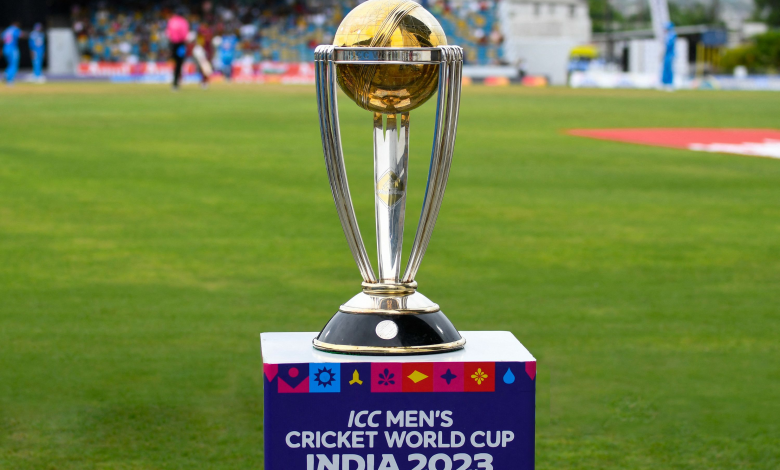
Cricket World Cup is set to begin on October 5 in India, with ten nations vying for the title over a six-week span. It promises sold-out stadiums, ecstatic fans, and the familiar sound of hooting vuvuzelas.
On the surface, it seems like a global event: cricket has over one billion admirers, making it one of the world’s most popular sports. Despite its lengthy history, the cricket market remains concentrated in a few countries, with India leading the way.
Cricket, which originated in the United Kingdom, started to expand with the expansion of the British Empire. International matches were initially played in the later part of the nineteenth century. Nonetheless, despite its lengthy history and growth, cricket has had difficulties in expanding its global influence outside Commonwealth countries.
Powerhouses like India, Australia, and England dominate cricket on the pitch. Off the pitch, these nations have significant power in the sport’s governing institutions. Aside from the ‘Big Three,’ notable cricketing nations include Pakistan, New Zealand, Sri Lanka, South Africa, Bangladesh, and the West Indies, which comprises Caribbean countries.
Unfortunately, cricket’s popularity remains concentrated in these countries, limiting its global spread.
FIFA, the governing organization of football, has approximately 200 members, but the International Cricket Council (ICC) has just 12 full members, with several additional nations having associate member status.
The 50-over World Cup, cricket’s pinnacle event, has varied in terms of team participation, hosting up to 16 countries in the 2007 edition but limiting it to a select group of top-performing nations in subsequent editions, including the 2018 competition.
The next World Cup, in 2027, will contain 14 teams, which is still much less than the 32 nations that have competed in the football World Cup since 1998. Furthermore, the next World Cup in football will have 48 teams in 2026.
This begs the issue of whether the cricket World Cup can pique interest in the sport outside of its present strongholds, or if shorter forms like Twenty20 (T20) cricket, with its 20-overs-a-side games, are more suited to expanding cricket’s global reach. The future of cricket on a global basis is being debated.
To summarize, cricket has growth potential, but it is unlikely to become a global phenomenon in the near future. Experts believe that T20 cricket, with its three-hour style, is the key to expanding the sport, especially with the advent of franchise leagues in new areas like the United States. Women’s cricket’s growth may also help to improve the sport’s global presence, and a possible return to the Olympic Games might give a significant boost.
Why is Cricket Not Global?
Unlike football, cricket requires a significant financial commitment, which includes the purchase of necessary equipment, the construction and maintenance of stadiums, and the care of fields.
The substantial equipment necessary even for casual play, according to Matt Roller, assistant editor at ESPNCricinfo, creates a rather high entrance barrier for cricket. According to him, this is the major reason for football’s global success, since all it need is a ball and a tiny area.
Nonetheless, according to numerous analysts, additional reasons contribute to cricket’s limited expansion outside its traditional strongholds. The sport’s historical links are one notable element.
Jamie Alter, a cricket commentator and writer, emphasized that the sport’s colonial beginnings have led in its close link with Commonwealth countries. Alter stated that the game is strongly embedded in the traditions of these nations, making it difficult to expand its footprint globally. Notably, countries with significant cricket history, such as India, Pakistan, and Bangladesh, represent a roughly two billion-person market.
To summarize, although cricket has significant obstacles in expanding its global appeal, colonial heritage, financial constraints, and cultural links to individual nations are among the primary reasons restricting its expansion outside its core markets.
Furthermore, cricket’s economic success, notably in countries like India, England, and Australia, has contributed to its isolation. This economic power may sometimes dull administrators’ desire to expand the sport’s global influence.
Nonetheless, it is important to note that the pool of cricket-playing nations has not stayed constant. Afghanistan, for example, has made significant gains in the development of the sport.
Although historical records show British engagement in cricket in Afghanistan in the nineteenth century, the sport acquired traction in the war-torn country during the last two decades among refugees who played in Pakistani camps.
Afghanistan’s national cricket team beat Scotland in their first 50-over World Cup participation in 2015, a significant accomplishment. Afghanistan was given test status in 2019, the highest level of cricket play. Following that, the squad won against two additional test-playing nations, Bangladesh and Ireland. Afghan cricketers have also become regulars in T20 franchise competitions throughout the globe.
Despite these encouraging signs, there is little suggestion that cricket administrators are planning to imitate Afghanistan’s success. Some analysts suggest that these administrators may be wary of upstart teams from lesser areas generating shocks, especially in renowned games like the World Cup.
Growing at a Slow Pace’
Cricket World Cups are sometimes criticized for having a small number of participating teams. According to Tim Wigmore, deputy cricket reporter for The Daily Telegraph and co-author of the book Crickonomics, these competitions are badly conceived owing to their lengthy duration and tiny team pool. The upcoming 10-team World Cup in India, for example, would contain 48 matches spread across 46 days, but the 2022 football World Cup in Qatar, with 32 teams, lasted less than a month.
Wigmore claims that cricket has been too cautious in terms of the number of teams permitted in World Cups. He believes that conservatism is not wholly blameless. The 50-overs World Cup included 16 teams in 2007. However, Ireland overcame Pakistan and Bangladesh defeated India, forcing both South Asian countries to withdraw from the tournament early. Following tournaments, the number of participating countries was “perversely” decreased, probably to guarantee that teams from bigger markets had more games.
Women’s World Cups are likewise restricted in terms of squad size. The inaugural Women’s World Cup was held in 1973 with seven teams, and participation has fluctuated throughout the years, peaking at 11 in 1997. The most recent Women’s World Cup in 2022 had eight teams, and the 2025 tournament will have the same number.
Tim Wigmore, deputy cricket writer for The Daily Telegraph and co-author of the book Crickonomics, believes that more teams should be included in World Cup events. Despite this, the upcoming ODI World Cup contains just 10 teams, and the number of teams in women’s World Cups continues to expand slowly. One Day Internationals, or ODIs, are 50-over-a-side contests between international teams.
Georgie Heath, a cricket analyst and broadcaster, emphasizes the necessity of efficiently marketing World Cups in order to attract new fans. She believes that contemporary cricket advertising often targets existing cricket fans rather than concentrating on attracting new viewers, players, and enthusiasts while emphasizing the sport’s attraction.
In addition, restricted accessibility owing to pay-to-view television broadcasts and expensive ticket costs are impediments to expansion. Many cricket fans have voiced their displeasure with the erratic ticketing system for the upcoming World Cup. Official ticket prices vary from 499 rupees ($6) to 40,000 rupees ($481) on outlets such as BookMyShow. Ticket prices may be astronomical in the resale market, with some tickets for the highly anticipated India vs. Pakistan match selling for as much as 25 million rupees ($300,545) on Viagogo, a worldwide ticket exchange and resale business.
Furthermore, concerns regarding the ODI format’s future in cricket are growing more prevalent.
The Future: 20 or 50 Overs?
The Marylebone Cricket Club (MCC), which oversees the game’s regulations, recommended restricting the number of ODI internationals after the 2027 World Cup in July. This advice is consistent with the current trend of the 50-plus format losing favour. Traditional cricket fans continue to prefer lengthier five-day test matches, while casual viewers prefer the faster and more glamorous 20-over-a-side style, which has spawned multiple franchise leagues.
However, cricketers are not fully ready to say goodbye to One-Day Internationals.
According to a 2022 survey by the Federation of International Cricketers’ Association, a worldwide players’ representative group, 54 percent of cricketers still consider the One-Day International World Cup to be the most prestigious competition in which to participate. Although this number has dropped dramatically from 86 percent in the 2018-19 poll, it indicates that ODIs continue to be important to players.
Assistant editor at ESPN Cricinfo, Matt Roller, believes that one-day cricket may see less international playtime, but the World Cup will likely remain the peak event that players strive to be a part of. He observes that franchise leagues are increasingly challenging bilateral international cricket, and that private investors prefer the fast-paced attraction of short-form cricket to 50-over leagues.
According to Matt Roller, the annual T20 World Cup is a more viable path for cricket’s expansion. According to Tim Wigmore, a cricket writer and novelist, the upcoming T20 World Cup, which will include 20 teams, its biggest participant pool to date, is predicted to considerably help to cricket’s expansion.
This expansion, however, may be fraught with difficulties. Lower-ranked teams may struggle to stay competitive due to their small share of T20 World Cup central broadcast income. This constraint limits their ability to reinvest in sport promotion. Furthermore, holding the game every two years may reduce its status, since the scarcity of World Cups in other sports adds to their attractiveness.
Some commentators feel that T20 cricket, especially franchise leagues, has a brighter future than international matches.
The Successful Business Building
Former ICC CEO David Richardson said in 2018 that it was obvious that T20 cricket will be the format through which the governing body could expand and globalize the sport.
In the year 2023, the T20 format seems to be booming. Domestic and franchise leagues are taking place in regions all over the world, including Africa, the Americas, Asia, Oceania, and parts of Europe.
Since its start in 2008, the Indian leading League (IPL), with an estimated brand worth of $8.4 billion, has established itself as the world’s leading T20 tournament. Profitable leagues have also sprung up in Australia, the UAE, South Africa, England, Wales, Pakistan, the Caribbean, and, most recently, the United States.
Bharat Sundaresan, a cricket writer for the Cricbuzz website, argues that, although T20 cricket has already expanded the sport, the key to cricket’s long-term and global expansion rests in the leagues that are sprouting throughout the globe, such as those in the United States and the United Arab Emirates. He sees a future in which new leagues might emerge in other countries if the chance comes, adding to the global development of cricket.
With the creation of Major League Cricket, featuring six teams participating in the T20 format, cricket made its debut in the world’s richest market, the United States, in July. Major League Cricket has attracted an excellent set of investors, with four of its six franchises controlled by corporations that also own IPL teams.
The United States, along with the West Indies, will host the T20 World Cup next year, providing a chance for the sport and the T20 format to grow in both regions.
Bharat Sundaresan remarked that, regardless of their objectives, IPL franchise owners have proved their capacity to operate successful companies, which may help to the expansion of cricket in other parts of the globe.
“Their business is so reliant on their brand being showcased for a longer period of time throughout the year rather than just for two months that they’re buying out all the teams around the world.” “It’s only going to lead to more leagues,” he continued.
Sundaresan also believes that women’s cricket will play an important part in improving the sport’s global image. Earlier this year, the inaugural full-fledged five-team Women’s Premier League (WPL) saw numerous female cricketers earn the greatest payoff of their careers at the auction.
Meanwhile, the FairBreak Invitational T20 hosted its second edition in Hong Kong this year, featuring some of the top female cricket players in the globe who took part in the six-team tournament.
“I think women’s cricket will popularize cricket as a sport more globally than what men’s cricket has been able to do in the last 150 years,” Sundaresan said.
He noted Thailand’s amazing rise – a country with no recognised history in the sport – as a breeding ground for potential in the women’s game. They qualified for their first global tournament, the Women’s T20 World Cup, in 2020, and the team has been rated as high as 10th globally.
Thai players have also piqued the interest of franchise leagues. Natthakan Chantham, the Trailblazers’ opening batter in the Women’s T20 Challenge tournament in India in 2020, became the first Thai cricketer to play in a professional T20 franchise league. This year’s FairBreak Invitational T20 featured all-rounders Nattaya Boochatham and Sornnarin Tippoch, as well as batter Naruemol Chaiwai.
“Suddenly, it’s a free-for-all, right?” Sundaresan explained. “Like, you can be part of a national team in a country which doesn’t have a great standard of cricket, but you have a tournament to go to and play.”
An Olympic Medal, then?
T20 cricket is also inspiring grander dreams for the game. Cricket, which was last featured at the 1900 Games in Paris, has made a request to be included in the Los Angeles Olympic Games in 2028 by the sport’s officials.
A five-team T20 tournament for both men and women is proposed.
Will cricket’s inclusion as an Olympic sport, though, help it expand its global reach? Not everyone is certain.
“I’d love to see cricket played at the Olympics for the second time, especially since it will include women playing cricket,” said Heath, a pundit and broadcaster.
“My reservations here lie in considering how many countries will be included, what the qualification routes are, who plays, and the danger that it just becomes another tournament of the same countries playing out as we always see.”
Other analysts concur that, although Olympic participation may increase cricket’s global prominence, it is unlikely to change the game’s global footprint overnight.
“A small T20 tournament might not be transformative in itself and would likely be played by only a few teams in the first instance,” Roller said.
Roller pointed out that an Olympic medal does not always imply that cricket has attained global stature. “There are a number of relatively niche sports at the Olympics already, which are much smaller than cricket in terms of participation numbers or audience.”
Indeed, some observers question if cricket should seek to have a presence in every part of the globe.
“I love cricket and always will, but I don’t see how it going to the Olympics is going to significantly promote the sport,” Alter said.
“Is it necessary for cricket to be a global sport?” It has been successful in its own universe for nearly 150 years.”




